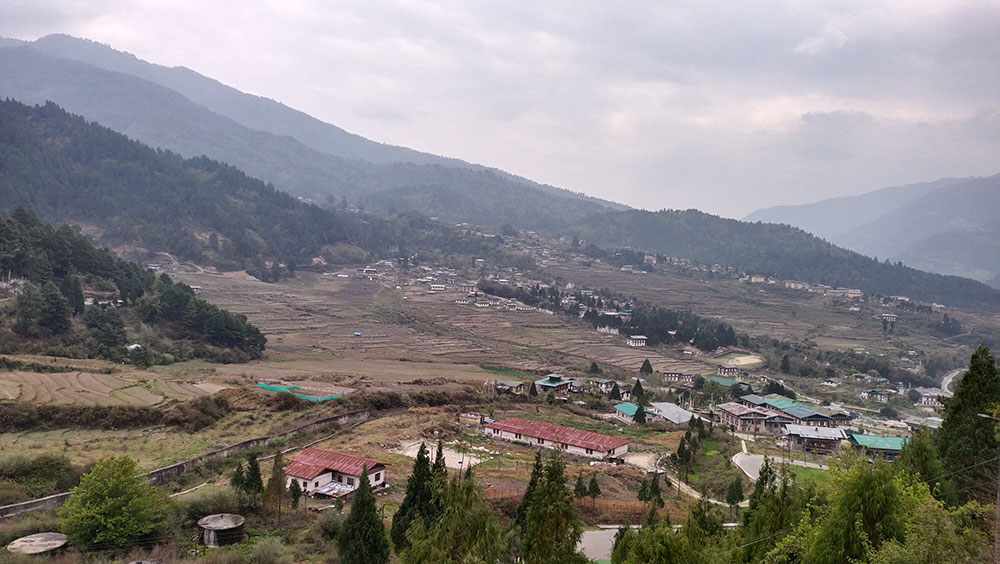Neten Dorji
Trashiyangtse—Black-necked Crane (BNC) conservation in Bumdeling, Trashiyangtse is facing threats due to habitat degradation caused by the expansion of Yangtse town and natural calamities, according to experts.
National coordinator for crane conservation from the Royal Society for Protection of Nature (RSPN), Jigme Tshering, said that the primary reason for the decline in visitors is the change in land use practices and the abandonment of farmland.
“Disturbances in the bird’s roosting area in Bumdeling due to major floods in the 1990s and the diminishing feeding grounds, such as paddy fields, are among the reasons for the declining number of visitors,” said Jigme Tshering, adding that the habitats of the cranes are being degraded and encroached upon by the increasing development activities.

Expansion of Yangtse town and calamities indirectly shrinking the feeding ground for cranes
Over the years, according to RSPN officials, the number of winged visitors in Bumdeling has been steadily declining. When they first began recording crane arrivals in 1987, there were more than 200 cranes flying in annually.
The numbers declined to 119 cranes arriving in 2019 and 70 cranes in 2022. Only 62 cranes visited Bumdeling last year.
The expansion of the Yangtse town has indirectly contributed to the decreasing feeding grounds for the cranes.
Bayling-Yangtse chiwog tshogpa, Dechen Tobgay, said that the government and other conservation offices have been supportive of crane conservation, but there is still pressure from the growing concrete structures.
“The area around the town has many abandoned paddy fields that could be revived as feeding grounds with the support of electric fencing and irrigation canals,” said Dechen Tobgay.
He further suggested that by restoring all the abandoned paddy fields, which have now turned into forested areas in Bumdeling, as well as in other areas like Tshaling and the opposite of Tshaling area, the number of visitors could potentially increase in the future.
Senior park official of Bumdeling Wildlife Sanctuary, Sangay Drakpa, said that a decline in visitors is attributed to insufficient grains and a shortage of foraging ground for the cranes.
“It not only affects the number of visitors but also impacts the livelihoods of local people,” he said. He also noted that the RSPN has been at the forefront of efforts to restore habitats and livelihoods in the area.
The five approaches to crane conservation in Bhutan are research and monitoring, habitat management, global or local coordination and partnership, environmental education and advocacy, and community engagement and sustainable development.
Measures to address the issue were implemented through the establishment of two support groups in Bumdeling and Yangtse gewogs. With support from these groups, Bumdeling Wildlife Sanctuary (BWS) clears the roosting area before the arrival of the birds each year. Winter cropping is also discouraged to facilitate the cranes’ access to the paddy fields for feeding.
With support from RSPN, approximately 51.6 kilometres of electric fencing were constructed around abandoned paddy fields, which served as crucial feeding grounds for the cranes.
Officials said that around 156 households received electric fencing between 2018 and 2023, leading to the reclamation of approximately 29 acres of land.
“This initiative not only restores the habitat of cranes but also enhances the social livelihood of local communities,” an official said.
Way forward
Jigme Tshering said that over the next three years, the RSPN would focus on habitat restoration efforts in Bumdeling and Yangtse to attract more cranes.
“We can attract more cranes if farmers could revive farming activities in Bumdeling Gewog,” he said. “Additionally, we are planning to promote a crane farewell festival to raise awareness in the community.”
RSPN conducts conservation awareness campaigns regularly.
In the future, if farmers produce more rice, RSPN plans to market the excess rice under the brand ‘Thrung-Thrung Rice’ to support crane conservation.
Trashiyangtse dzongrab gom, Wangchuk Dorji, said that taking ownership of cranes is critically important.
“Conservation of cranes is a priority for the dzongkhag administration,” he said. “It is a collective responsibility of the people in Trashiyangtse.”
The dzongkhag administration is working on reclaiming fallow land as part of crane conversation in the 13th Five-Year Plan.


